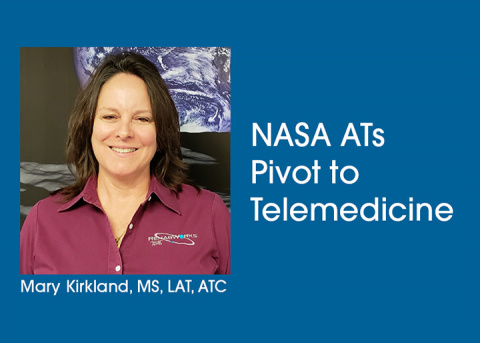
During the COVID-19 pandemic, athletic trainers have stepped up to help their communities and local health care systems in multiple ways, including screening, telemedicine and infrastructure. NATA will share what athletic trainers everywhere are doing to care for their patients, communities and themselves during this time.
Since March 18, the employees at NASA’s Kennedy Space Center, save for essential or mission critical personnel, were ordered to telework from home to combat the spread of COVID-19. That included the athletic trainers at RehabWorks, an on-site clinic that provides athletic training services to employees of the Kennedy Space Center and Cape Canaveral Air Force Station.
Managed by Mary Kirkland, MS, LAT, ATC, the RehabWorks health care team is now providing care remotely during the pandemic, and she said it has been a “game changer” for the clinic.
“[It is] one that opens the door to endless possibilities and the future use of telemedicine by all AT practice settings,” Kirkland said. “Acknowledging the fact that nothing adequately replaces the in-person patient interaction for assessment, diagnosis, treatment, rehabilitation and return to function, the addition of telemedicine to our AT profession is a skill set we all need to learn and utilize now and in future patient interventions.”
She shared more about her experience with transitioning to telemedicine quickly and efficiently, and how it is working for her patients and her team.
Technology, Check
“Commercial video conferencing software became our primary communication platform for chats, video and document sharing. My staff and I developed telemedicine instructions and a pre-screening form to streamline our process and ensure that personally identifiable information and HIPAA regulations were followed at all times.
“To date, we have had great success using video conferencing, in addition to our normal encrypted NASA email in maintaining continuity of patient care for the Kennedy Space Center workforce.”
Telemedicine vs. In-Person
“Not having the ability for hands-on evaluation and treatment is the biggest difference for us with regard to telemedicine. By using a private video chat, we have the ability to ‘see’ the patient, have them show us the relevant anatomy, demonstrate range of motion and test out various movement patterns that can assist in rendering a diagnosis on a virtual patient.
“Our documentation clearly states, ‘This is a telemedicine consultation – no hands-on testing was performed and that the patient’s consent to treat authorization included telemedicine evaluation and diagnosis.’ That is our effort to clearly state that we are providing health care via a virtual platform. Each of my online consultations/evaluations thus far has been met with great success and appreciation by the employee for enabling them to remain safely at home while mitigating or resolving their musculoskeletal issue.”
Keeping Morale Up
“As we were preparing to leave the RehabWorks clinic on March 17 with an unknown return-to-work timeline, I was open and honest with my staff of having never been through something like this. We shut down the clinic as if we were not returning for a long time and each staff member was able to take home whatever resources they needed to make telework and maintaining some semblance of normalcy as easy as possible.
“We maintain regular communication via cell phone, texting, emails and video tag ups. We begin each tag up with updates on ourselves, our families and our pets before moving into the work-related topics. Maintaining contact with active patients also keeps us busy and focused on the task at hand.
“I try to address any questions or resource needs ASAP, and require each staff member take one hour per day for a physical activity break to avoid a telework injury as well as ensure that their mental/emotional health stay as high as possible, given this unique and world-altering pandemic event.
“At NASA, ‘Failure is not an option.’ We take this mandate to heart and we will rise to new heights and learn new capabilities that will serve us now and into the future.’
Athletic Trainers in Uncertain Times
“Having been a credentialed AT for 33 years, I have found that my fellow colleagues will always find a way to rise to the occasion and make the most out of their situation.
“I am also confident that many, if not all of them, have ‘figured it out’ and taken the steps necessary to work within this new normal and provide the highest level of health care to their patients.
“Additionally, this is one of the most open and accepting professions that I know. As such, the net is spread open wide to capture and hold all of us and make sure that no one goes without aide or assistance. Friend helps friend and colleague helps colleague. We are in this together and each AT shares their best practices for success to the betterment of all in our amazing profession.
“Ad Astra Per Astra (‘Through hardships to the stars’) – Every American is learning this now and if we take the time to help each other, then COVID-19 has not beaten us, but has made us that much stronger of a nation.”





